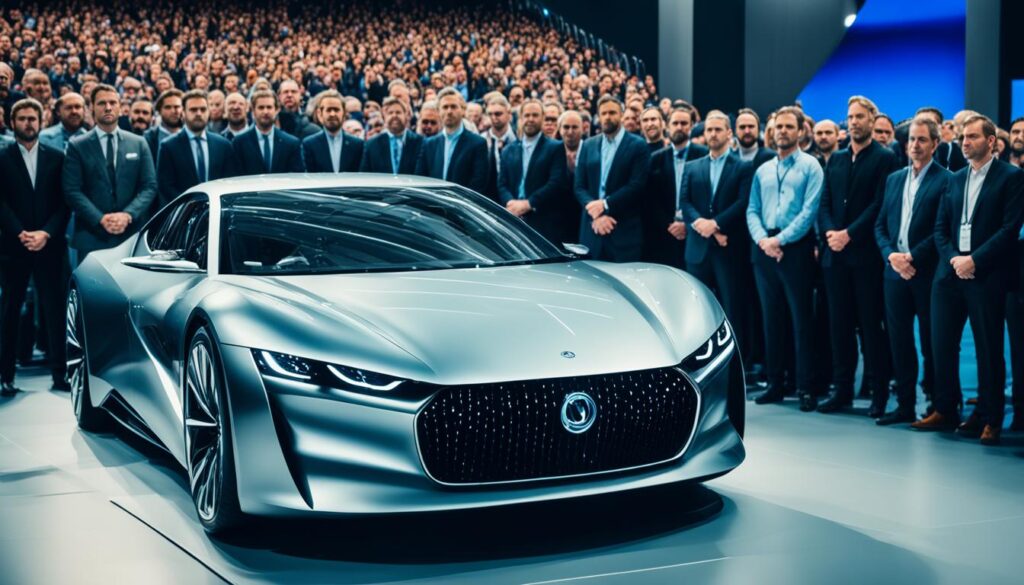Can a car company recover from a major scandal? This question is big in the automotive world. Brand reputation can make or break a business. We’ve seen big companies fall and small ones rise, all based on what people think and trust.
In the fast-paced automotive industry, reputation is key. A single mistake can hurt customer trust and sales for a long time. For example, the Ford Pinto, introduced over five decades ago, still gets jokes about its reliability today1. This shows how important it is to have good strategies for fixing a damaged reputation in the automotive sector.
Fixing a damaged image is hard. Companies face many challenges, like recalls and data breaches, which can quickly turn into big PR problems2. Social media makes these issues spread fast.
But, there is hope. We’ve seen big comebacks in the industry. Toyota recovered from a crisis with over 200 accidents and an estimated 89 deaths linked to unintended acceleration1. They used clear communication, big recalls, and improved quality control to get back on track.
The automotive industry is changing a lot. We’re moving towards a new way of thinking where mobility is seen as a service, and cars are more connected, self-driving, and electric. This change brings both chances and challenges for managing a brand’s image.
Key Takeaways
- Reputation crises can have long-lasting impacts on automotive brands
- Social media amplifies reputation risks in the automotive industry
- Transparent communication is crucial for crisis management
- Product recalls, while costly, can be effective in rebuilding trust
- The automotive industry is shifting towards new mobility services
- Proactive reputation management is essential in the evolving automotive landscape
Understanding the Impact of Crises on Automotive Brand Reputation
Crises in the automotive industry can really hurt a brand’s reputation. This damage can last a long time, affecting how people see the brand and how loyal customers are. In today’s digital world, online reviews are key to how people view brands. A huge 93% of car buyers check out online reviews before they buy, and 85% trust these reviews as much as advice from friends3.
The car industry is very sensitive to damage to its reputation. About 70% to 80% of its value comes from things like brand name and good will4. So, keeping a good brand image is very important. Brands with a strong reputation can attract better employees and charge more for their products.
Let’s look at how a crisis affected Toyota. In late 2009, Toyota faced big quality issues, leading to the recall of about 9 million vehicles in just six months5. This crisis deeply hurt Toyota’s reputation for quality, which they had worked hard to build.
| Impact Factor | Percentage |
|---|---|
| Potential customer loss due to negative reviews | 22% |
| Consumers willing to change opinion after business response | 70% |
| Consumers looking for recent reviews | 80% |
The table shows how important customer feedback is to a brand’s image. Bad reviews can make up to 22% of potential customers switch sides, showing the need for good crisis handling and quick customer care3.
To lessen the blow of crises, car companies should focus on preventing risks rather than just reacting to them. This way, they can keep trust with customers, address safety worries, and get through tough times after a crisis.
Immediate Response Strategies for Crisis Management
In the automotive industry, quick action is key when facing a crisis. We must act fast and communicate clearly to address customer concerns. Social media is crucial for sharing updates and talking directly with customers6.
Our public relations team should be ready to move quickly. They need to share clear and honest info to keep trust. Being open about the issue, explaining how we plan to fix it, and keeping the public updated is essential.

Most car shoppers look online for info, making digital platforms key for handling crises6. We must use these channels well to reach our audience and shape the story.
Quick recalls show we care about customer safety. Having top management in public statements shows we’re serious. This helps rebuild trust fast and protects our brand.
About 76% of consumers will leave a company after one bad experience6. This highlights the importance of a solid crisis plan. By quickly responding to reviews, we can keep customers and gain new ones7.
A crisis can be a chance to show our dedication to customers and our industry. By managing it well, we can come out stronger and more trusted.
Long-term Automotive Industry Reputation Recovery Strategies
Rebuilding a brand in the automotive sector needs a detailed plan. The use of online channels in Europe went up by 13 percentage points during the COVID-19 crisis8. This shows how vital a strong online presence is for improving customer experience.
Improving continuously is key for lasting success. European car companies lost €4.3 billion last year9. To get past this, companies should focus on new ideas and being green.

Keeping cars safe is a top goal. Factories are not making enough money to be profitable9. Companies need to cut costs wisely while keeping safety high. This approach helps rebuild trust and recover reputation over time.
The industry is set to grow. Sales are expected to rise by 11% from 2023 to 202510. To take advantage of this, companies should work on making better products and use new tech, especially in electric cars.
| Region | Average New Car Price | Average Household Income | Price to Income Ratio |
|---|---|---|---|
| Japan | $25,000 | $32,000 | 78% |
| US | $46,000 | $62,000 | 74% |
| Germany | $47,000 | $44,000 | 107% |
This table shows how new car prices vary around the world10. To fix this, companies need to come up with new pricing and product plans. This will be key for rebuilding brands globally in the car industry.
Case Studies: Successful Reputation Rebuilding in the Auto Sector
The automotive industry has faced many crises, but some companies have turned these into chances for a brand turnaround. Let’s look at a few examples of how they recovered their reputation successfully.

In 2009-2010, Toyota had a big problem with over 8 million vehicles recalled worldwide because of a faulty acceleration issue11. They quickly acted by recalling about 4.2 million vehicles in November 2009, then added another 2.3 million by January 201012. Toyota’s CEO, Akio Toyoda, apologized publicly, showing they took responsibility11.
To win back trust, Toyota used many ways to communicate. They told customers directly, briefed dealers, and shared info online11. They also set up a special quality committee, improved their quick response teams, and built new testing facilities to avoid future problems11.
Volkswagen faced a big crisis in 2015 with an emissions scandal. They took steps to fix their image by investing $20 billion in electric and hybrid cars by 202313. This move helped them become the #1 car maker in 2018 again. It showed Volkswagen as a leader in green transportation.
| Company | Crisis | Recovery Strategy | Outcome |
|---|---|---|---|
| Toyota | Unintended acceleration | Comprehensive recalls, public apology, quality improvements | Restored trust, enhanced safety measures |
| Volkswagen | Emissions scandal | Investment in electric vehicles, transparency | Regained market leadership, improved sustainability image |
These stories show how key transparency, accountability, and a focus on betterment are in crisis recovery. By acting fast and putting customers first, these companies rebuilt trust and came out stronger from their crises.
Conclusion: Building a Resilient Brand Image in the Automotive Industry
Brand resilience is key in the automotive world. A whopping 88% of brand leaders see reputation risk as a major worry14. This shows we need a strong plan for the future. We must go digital and focus on what customers want to lead.
The trends are clear: we’re heading towards connected, self-driving, and electric cars. This change brings new hurdles for managing our image. Yet, it also opens doors for showing off our innovation. Ford’s comeback from $6.2 billion profits in 2011 to $8.3 billion in 2013 shows we can recover with the right strategy15.
We need to sharpen our skills in managing our reputation. This means being prepared for crises, being open, and meeting customer needs. Remember, over 65% of business leaders think social media can make a brand crisis worse in our field14. So, we must be very careful online. By focusing on these areas, we can build stronger, more resilient brands for the future.
FAQ
What are the key strategies for effective reputation recovery in the automotive industry after a crisis?
How can crises in the automotive industry impact brand reputation?
What are the immediate response strategies for crisis management in the automotive industry?
What long-term strategies can automotive companies employ for reputation recovery?
Can you provide examples of automotive companies that successfully rebuilt their reputations after crises?
What strategies can automotive companies employ to build a resilient brand image?
Source Links
- 10 Enterprise Reputation Crisis Management Comebacks – https://www.widewail.com/blog/10-enterprise-reputation-crisis-management-comebacks
- Surviving Reputation Crises: Strategies for Long-Term Recovery – https://www.linkedin.com/pulse/surviving-reputation-crises-strategies-long-term-adam-roosevelt-oc8rf
- How You Can Save Your Brand With Automotive Reputation Management – Spitz Solutions – https://spitzsolutions.com/how-you-can-save-your-brand-with-automotive-reputation-management/
- Reputation and Its Risks – https://hbr.org/2007/02/reputation-and-its-risks
- PDF – http://www.diva-portal.org/smash/get/diva2:349746/FULLTEXT02.pdf
- Automotive Reputation Management: The Complete Guide | InMoment – https://inmoment.com/blog/automotive-reputation-management/
- Automotive Reputation Management – What is it & How to Do It? – https://www.demandhub.co/articles/automotive-reputation-management/
- Reimagining the auto industry’s future: It’s now or never – https://www.mckinsey.com/industries/automotive-and-assembly/our-insights/reimagining-the-auto-industrys-future-its-now-or-never
- Value recovery in the automotive industry – https://www2.deloitte.com/xe/en/insights/industry/automotive//automotive-industry-value-chain.html
- Automotive: In the midst of global transformation – https://kpmg.com/xx/en/home/insights/2023/08/automotive-in-the-midst-of-global-transformation.html
- Building Trust: Toyota’s Recall Strategy and Crisis Communication – https://www.ineak.com/building-trust-toyotas-recall-strategy-and-crisis-communication/
- Resilience Tested: Toyota Crisis Management Case Study – https://changemanagementinsight.com/toyota-crisis-management-case-study/
- Reputation crisis management: top-5 cases – https://youscan.io/blog/reputation-crisis-cases/
- How to Recover from a Reputation Crisis and Rebuild Your Brand – Prowly – https://prowly.com/magazine/brand-reputation-crisis/
- The Decline and Resurgence of the U.S. Auto Industry – https://www.epi.org/publication/the-decline-and-resurgence-of-the-u-s-auto-industry/

